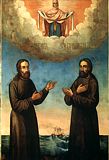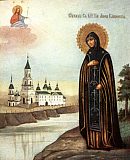

| Previous day | Next day |
| Old Style
June 12
|
Tuesday |
New Style
June 25
|
|
2nd Week after Pentecost.
Tone 8.
Fast of the Holy Apostles. |
Wine and oil allowed.
|
![]() St. Onuphrius the Great (4th c.).
St. Onuphrius the Great (4th c.). ![]() St. Peter of Mt. Athos (734).
St. Peter of Mt. Athos (734).
Sts. John, Andrew, Heraclemon, and Theophilus, hermits, of Egypt (4th c.). St. Arsenius, founder of Konevits Monastery (1447). St. Onuphrius, founder of Malsk Monastery (Pskov) (1492). Sts. Onuphrius and Auxentius, monks, of Vologda (15th c.-16th c). St. Stephen of Komel, founder of Ozersk Monastery (Vologda) (1542). Sts. Jonah and Bassian, monks, of Pertoma (Solovki) (1561). First (1650) and second (1909) glorifications of St. Anna, princess of Kashin (Euphrosyne in monasticism). St. Onuphrius, founder of Katrom Monastery (Vologda) (16th c). Uncovering of the relics of St. John of Moscow, fool-for-Christ (1672).
Miracle-working icons of the Theotokos and St. Onuphrius at St. Onuphrius Monastery (Poland).
St. Amphianus, bishop and confessor, in Cilicia (ca. 310). St. Olympius, bishop and confessor, in Thrace (4th c.). St. Timothy the Hermit, of Egypt (4th c.). Virgin-martyr Cunera of Rhenen (Neth.) (451). St. Julian of the Dagouta Church in Constantinople. St. John the Soldier, of Egypt (6th c.-7th c.). St. John (Tornicus) of Mt. Athos and Georgia (998). Synaxis of the Saints of St. Onuphrius Monastery at Jablechna (Poland). St. Triphyllius, bishop of Leucosia [Nicosia] on Cyprus (370).
Repose of Elder Peter of Katounakia, Mt. Athos (1867), and Blessed Hermit Philaretus of Mt. Athos (1961).
Thoughts for Each Day of the Year
According to the Daily Church Readings from the Word of God
By St. Theophan the Recluse

Tuesday. [Rom. 4:4–12; Matt. 7:15–21]
Beware of false prophets (Matt. 7:15). From the beginning of Christianity and to this day there has not been a time when this warning was not applicable. The Lord did not indicate exactly which false prophets to beware of, for how could they be pinpointed? They change like fashions and are continually generating more like them. They always appear in sheep’s clothing, with a likeness of good will in their deeds and a mirage of truth in their speech. In our time their clothing is sewn of progress, civilization, education, freedom of thought and deed, a personal conviction which does not allow for faith, and such like. All of this is a deceptive cloak. Therefore, if you come across this show of clothing, do not be hasty to open your ears to the words of “prophets” dressed in such clothes. Examine closely whether there is a wolf concealed under this sheep’s clothing. Know that the Lord is the only motivator toward true perfection, the sole softener of hearts and customs, the sole educator, the sole giver of freedom and filler of the heart with a feeling of the truth which forms a conviction so strong that nothing in the world has the power to shake it. Therefore, as soon as you perceive in these new “prophets’s” talk some shadow of contradiction to the teaching of the Lord, know that they are predatory wolves, and turn away from them.
Articles
 Venerable John the Hermit of EgyptSaint John the Hermit lived in Egypt in the fourth century, and is mentioned in the Life of Saint Onuphrius. |
 Venerable Andrew the Hermit of EgyptSaint Andrew lived in Egypt in the fourth century, and is mentioned in the Life of Saint Onuphrius. |
 Venerable Heraclemon the Hermit of EgyptSaint Heraclemon lived in Egypt in the fourth century, and is mentioned in the Life of Saint Onuphrius. |
 Venerable Theophilus the Hermit of EgyptSaint Theophilus lived in Egypt in the fourth century, and is mentioned in the Life of Saint Onuphrius. |









